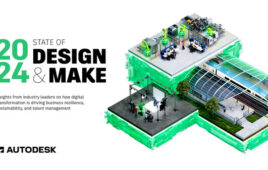The best choice for 3D data exchange, collaboration, and archiving may be a format that almost died a few years ago.
The PDF format was invented by Adobe over 18 years ago. It’s grown to become the de-facto worldwide standard for the reliable distribution, exchange, and archiving of electronic documents. Yet, there was some doubt a few years ago whether PDF would be important in the realm of 3D CAD.
This 3D PDF is an example of documentation that could be distributed to OEM’s along with “first article” parts. The form features a Submit button that can send data entered back to a quality tracking database. The embedded 3D is a fully manufacturable solid model.Adobe enters, and exits, the 3D CAD market.
Some years back, around 2006, Adobe embarked on an initiative to get into the 3D CAD market by adding 3D capabilities to the PDF format. The plan had several parts: First, acquire company (Trade and Technologies France) with a bunch of relevant CAD-related technology (3D CAD translators, and the PRC 3D data format.) Second, define a new version of the PDF format (PDF/E-2) incorporating 3D data structures, including PRC (an exact representation, suitable for data exchange), and U3D (a lightweight representation, suitable for viewing.) Third, update the free Acrobat PDF reader to support 3D PDF. Fourth, sell advanced versions of Acrobat Pro with support for 3D, so users could publish their own 3D PDF files. And, fifth, license a 3D PDF software development kit (SDK) to CAD (and other technical software) developers, so they could add 3D PDF publishing capabilities to their products.
It was a big plan, but it met with some resistance and disinterest from CAD vendors, given their preference in promoting their own quasi-open 3D formats (e.g., JT, 3DXML, DWF, eDrawings.) With enough time, Adobe might have been wildly successful with their 3D initiative, but, as often happens in big corporations, changing corporate priorities caused it to fall out of favor. In November, 2009, Adobe decided that 3D CAD was not their core competency, and they essentially shut-down all their development efforts in the area.
That could have been the end of 3D PDF as a meaningful format in the 3D CAD world. Fortunately, Adobe found a company that was willing to acquire their CAD-related technology, and support 3D PDF in the 3D CAD market: Tech Soft 3D.
Ultimately, Tech Soft 3D acquired the software and technology necessary for authoring 3D PDF files. Adobe held onto the rights to the technology necessary for displaying 3D PDF files, but contracted with Tech Soft 3D to handle development and maintenance for those technologies.
There was one piece of technology that didn’t have a home: Adobe Acrobat Pro Extended, high-end 3D PDF publishing product that included translators for authoring 3D PDFs from 3D CAD files. Tech Soft 3D is a developer of component software technologies that are used by a software developers within their products. They don’t sell to end-users, and didn’t want to be in the position of competing with their customers. As a result, a new company, Tetra4D, was formed to develop and sell 3D PDF Converter, an add in to Adobe Acrobat X Pro that provides the capability of reading 3D CAD files.
The birth of the 3D PDF consortium.
As a part of the process of transitioning its 3D technology, Adobe asked Tech Soft 3D to establish a working group to consolidate industry requirements for input into the ISO standardization process for the PRC data format used in 3D PDF, and the PDF/E-2 specification. AIIM, a standards group that works closely with ISO, took on the task of developing the ISO specifications for PRC and PDF/E-2.
In 2011, the 3D PDF Consortium was formed as an industry group, made up of developers, systems integrators, and users, to both promote 3D PDF, and to provide input to AIIM in establishing requirements for PRC and PDF/E-2.
With Adobe committed to providing long-term support for viewing 3D PDF in its Acrobat products, Tech Soft 3D committed to continuing development and support of the underlying technology for authoring 3D PDF, AIIM committed to supporting PRC and PDF/E-2 as ISO standards, and the 3D PDF Consortium committed to promoting the use of the format, 3D PDF went from the edge of the valley of death to being a legitimate standard. A safe choice for users.
Safe is not the same thing as important.
3D PDF is actually far more than safe. Through a confluence of events, 3D PDF has now become important.
Several years back, after over a decade of percolating in the background, the technology of CAD direct modeling broke out, and started to shake up the market. While there are as many versions of direct modeling as there are CAD vendors who support it, the common theme is the same: The ability to intelligently edit dumb CAD models (e.g., B-Rep 3D models with no feature or history information.) These are the kind of CAD models that can be found in IGES, STEP, JT, and 3D PDF files.
Similarly, PMI (product and manufacturing information, ASME Y14.41-2003 and ISO 1101:2004) has become very important over the last several years, with growing support from CAD vendors. STEP ap203e2, JT and 3D PDF all provide support for PMI.
There are two things that set 3D PDF apart from JT and STEP ap203e2: First, that tens of millions of people already have the free Acrobat viewer on their computer, and, second, that 3D PDF allows the creation of rich documents, containing not just 3D geometry and PMI, but much more.
This 3D PDF is a MIL-STD-31000 TDP (technical documentation package), including PMI.The Model Based Enterprise.
The US Department of Defense, through the Army Research Laboratory, has been working on an initiative called “Model Based Enterprise” (MBE), which they define as “A fully integrated and collaborative environment founded on 3D product definition detailed and shared across the enterprise; to enable rapid, seamless, and affordable deployment of products from concept to disposal.”
3D MBE is a product strategy for reusing the 3D CAD model by all of the downstream customers, versus recreating or re-entering the data it contains. At its core is the Model Based Definition (MBD), containing all of the information needed to define a product in an annotated and organized manner, in order to be read and the information automatically extracted by non-CAD users.
In the past, defense supply chain suppliers would deliver product information in several pieces, including a model, and drawing, and related instructions. With MBE, that information is delivered in a Technical Data Package (TDP), defined by MIL-STD-31000. It happens that the ideal format for creating these TDPs is 3D PDF.
Very soon, any company that is involved in the defense supply chain will be required to deliver their data subject to MIL-STD-31000. But the concept of model based definition, where the product definition is delivered in a “fit for purpose” TDP (i.e., 3D PDF file) is compelling in commercial applications too. The DoD estimates that, properly implemented, the MBE process can cut nonrecurring costs between 50% to 70%, and reduce time to market by as much as 50%.
Not just a data exchange format.
There are a number of commonly used neutral formats for representing 3D CAD data, including IGES, STEP (ap203e2), JT, DWF, 3DXML, eDrawings, and 3D PDF. Of these, STEP ap203e3, JT, and 3D PDF are modern ISO standards, and, as a result, are appropriate for use as canonical representations of product data. JT and 3D PDF provide the flexibility of supporting both exact and lightweight 3D representations.
STEP ap203e2 and JT have seen broad adoption in the aerospace and automotive industries. It will probably take a lot of work, and time, for 3D PDF to catch up. But the format has a tremendous amount of flexibility, and provides advantages in a number of use cases.
As an example, when creating 3D PDFs with Acrobat Pro X and Tetra4D 3D PDF Converter, you can:
-Access Microsoft SharePoint from any Acrobat Open or Save dialog box, open 3D PDF files from SharePoint for viewing, collaboration, and 3D data exchange, and check them out for editing.
-Use the free Adobe SendNow online services from within Acrobat to send, share, and track large files.
-Use the free Adobe Collaborate Live capabilities of Adobe Acrobat X Pro to conduct online design review. After you send the 3D PDF to the recipients, Collaborate Live connects them, so that only display commands (e.g., rotate, zoom, pan, change pages) are sent back and forth. This results in much better performance than traditional web conferencing.
The actual structure of 3D PDF files is dependent on the authoring application you use. Using Anark Core software, for example, you can create “fit for purpose” TDPs, self-contained RFQ packages, digital work instructions, inspection documents, and quite a bit more.
Many direct modeling CAD systems have the capability of reading and editing 3D PDF files. For example, SpaceClaim can read 3D PDF files containing PRC 3D data, and can write 2D and 3D U3D and PRC PDF files. When SpaceClaim reads PRC, the models come in as clean, editable solids, like any other imported solid.
3D PDF files are exceptionally flexible. They can be used for 3D data exchange, collaboration, archiving, and a variety of workflow-related tasks, including most anything that you might use IGES, STEP, JT, eDrawings, 3DXML, or DWF for. There are a significant number of vendors offering a wide range of high-quality 3D PDF authoring software. It looks like the format is only going to get more useful as time goes on.
3D PDF Consortium
www.3dpdfconsortium.org
Anark
www.anark.com
Model Based Enterprise
model-based-enterprise.org
SpaceClaim
www.spaceclaim.com
Tech Soft 3D
www.techsoft3d.com
Tetra4D
www.tetra4D.com
Filed Under: Software • 3D CAD, ENGINEERING SOFTWARE





Tell Us What You Think!